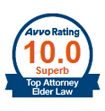Social Security Issues: Social Security Disability and Supplemental Security Income
Social Security Issues: Social Security Disability and Supplemental Security Income
By Donald D. Vanarelli, Esq.
Social Security Disability (“SSD”) and Supplemental Security Income (“SSI”) are two programs available from the Social Security Administration (“SSA”) that may play an important role in an elder law practice.
Major differences between the programs:
- SSD benefits are available only to those with sufficient social security earnings to be deemed “insured” for disability. SSI benefits are not based on insured status or the individual’s earnings. SSI benefits are paid to blind or disabled persons based upon that person’s income and resources.
- Unlike SSD, which is available to those who have not reached the age of retirement, SSI is available not only to the blind and disabled, but also to individuals over age 65.
- In New Jersey, individuals who receive SSI are also entitled to Medicaid benefits. After 24 months of SSD eligibility, individuals who receive SSD are entitled to Medicare Part A, and are eligible for Medicare Part B subject to payment of a premium.
Interplay between the SSI and SSD programs:
- An individual may receive benefits under both SSI and SSD, if he/she qualifies for both.
- The standards for the medical determination of disability are the same for the SSI and SSD programs for adults.
- Although an SSI recipient may receive up to $20 per month of unearned income without penalty, any unearned income in excess of $20 per month will be deducted from the SSI benefit on a dollar-for-dollar basis. Benefits received under SSD are considered “unearned income,” and those monthly benefits decrease the amount of SSI benefits to which the individual is entitled, on a dollar-for-dollar basis. POMS SI 00830.050; POMS SI 00830.210. Conceivably, a recipient’s social security benefit could reduce his or her SSI benefit to zero, resulting in a loss of Medicaid benefits.
SOCIAL SECURITY DISABILITY (“SSD”) BENEFITS
Available to a blind or disabled worker who:
- applies for benefits;
- has not reached full retirement age;
- has sufficient social security earnings to be deemed insured for disability;
- is disabled;
- has been disabled for a 5-month waiting period within the last 17 months prior to the month of application.
20 C.F.R. §404.315; 42 U.S.C. §423.
SUPPLEMENTAL SECURITY INCOME (“SSI”) BENEFITS:
Available to an aged (65 or older), blind or disabled individual who:
- applies for SSI and all other benefits for which he/she may be entitled;
- is a U.S. resident or qualified alien;
- is not a resident of a public institution;
- meets the income and resource requirements; and
- is not fleeing to avoid prosecution for a felony or violating probation or parole.
20 C.F.R. §416.202.
The Presumed Maximum Value Rule: When an SSI recipient has received food or shelter from an outside source, rather than determine the actual value of food or shelter received, Social Security will presume that the combined payments for food and shelter have a maximum value, which is the one-third of the federal benefit amount, plus $20. 20 C.F.R. § 1140; POMS SI 00835.300. Only the federal benefit (as opposed to the state supplement) is reduced.
THE APPEALS PROCESS:
Levels of appeal from an adverse determination:
- Reconsideration: A paper review of the file
- Hearing by an Administrative Law Judge: Hearing, including questioning of witnesses. Most reversals occur at this level.
- Review by the Appeals Council
- Federal Court review
Forms may be obtained online from www.ssa.gov.
The Hearing: Outline of Testimony
- Personal, educational, literacy/fluency, and mental aptitude background
- Work experience
- Impairment(s), including onset date, symptoms, medical sources consulted
- Current treatments
- Physical limitations
- Environmental restrictions
- Psychiatric limitations
- Pain
- Physical Residual Functional Capacity for various activities
- Daily activities of a typical day
- “Before and After” example of limitations
- Medical doctors
- Demonstrations
DETERMINING DISABILITY:
Disability is determined based upon the sequential analysis set forth in 20 C.F.R. §404.1520. According to the sequential analysis, a determination of disability is based upon a five-part analysis of criteria. The first two criteria are as follows:
- The claimant is not engaged in “substantial gainful activity” (“SGA”); and
- The claimant has a “severe” impairment, which will last at least 12 months (or result in death).
If the claimant satisfies the above two inquiries, the severity of the impairment is then analyzed as follows:
- The impairment meets or equals the severity of the listed impairments defined in the medical listing.
If the answer to this question is in the affirmative, then the claimant is disabled, according to medical listing. Otherwise, the inquiry is as follows:
- The claimant is unable to perform his/her “past relevant work” (“PRW”); and
- The claimant is unable to perform other work within his “residual functional capacity” (“RFC”).
If these latter questions are answered affirmatively, then the claimant is disabled according to vocational factors, even though the claimant has not satisfied the medical listing. ![]()
For additional information regarding Social Security Disability and Supplemental Security Income, call us at 908-232-7400 or click here to contact us online.







Vanarelli & Li, LLC on Social Media